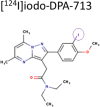Imaging tumor and ascites-associated macrophages in a mouse model of metastatic ovarian cancer
- PMID: 39612052
- PMCID: PMC11607259
- DOI: 10.1186/s13550-024-01157-8
Imaging tumor and ascites-associated macrophages in a mouse model of metastatic ovarian cancer
Abstract
Background: Tumor-Associated Macrophages (TAMs) play a critical role in the pathogenesis and progression of ovarian cancer, a lethal gynecologic malignancy. [124I]iodo-DPA-713 is a PET radiotracer that is selectively trapped within reactive macrophages. We have employed this radioligand here as well as a fluorescent analog to image TAMs associated with primary tumors, secondary pulmonary metastases and gastrointestinal tract-associated macrophages, associated with ascites accumulation in a syngeneic mouse model of metastatic ovarian cancer. Intact female C57BL/6 mice were engrafted with ID8-Defb29-VEGF tumor pieces. One month after engraftment, the mice were selected for positive bioluminescence to show primary and secondary tumor burden and were then scanned by PET/MRI with [124I]iodo-DPA-713, observing a 24 h uptake time. PET data were overlayed with T2-weighted MRI data to facilitate PET uptake tissue identity. Additionally, mice were imaged ex vivo using Near IR Fluorescence (NIRF), capturing the uptake and sequestration of DPA-713-IRDye800CW, a fluorescent analog of the radioligand used here. Additionally, cell culture uptake of DPA-713-IRDye680LT in ID8-DEFb29-VEGF, IOSE hTERT and RAW264.7 cells was conducted to measure tracer uptake in ovarian cancer cells, ovarian epithelial cells and macrophage.
Results: PET/MRI data show an intense ring of radiotracer uptake surrounding primary tumors. PET uptake is also associated with lung metastases, but not healthy lung. Mice displaying ascites also display PET uptake along the gastrointestinal tract while sham-operated mice show minimal gastrointestinal uptake. All mice show specific kidney uptake. Mice imaged by NIRF confirmed TAMs uptake mostly at the rim of primary tumors while 1 mm secondary tumors in the lungs displayed robust, homogeneous uptake of the radio- and fluorescent analog. Ex vivo biodistribution of [124I]iodo-DPA-713 showed that contralateral ovaries in middle-stage disease had the highest probe uptake with tissues sampled in mid- and late-stage disease showing increasing uptake.
Conclusion: [124I]iodo-DPA-713 and DPA-713-IRDye800CW sensitively identify and locate TAMs in a syngeneic mouse model of metastatic ovarian cancer.
Keywords: Ascites; ID8-Defb29-VEGF; Macrophages; Ovarian cancer; TAMs; iodo-DPA-713.
© 2024. The Author(s).
Conflict of interest statement
Declarations. Ethics approval and consent to participate: The study was performed in accordance with the ethical standards as laid down in the 1964 Declaration of Helsinki and its later amendments or comparable ethical standards. All methods were carried out in accordance with relevant guidelines and regulations. All rodent studies were approved by the Johns Hopkins IACUC. The study was carried out in compliance with the ARRIVE guidelines Consent for publication: Not applicable. Competing interests: C.A.F. holds a patent share in DPA-713-IRDye800CW, currently licensed to D&D Pharmatek. No other competing interests.
Figures






References
-
- Beiderwellen K, et al. 18)F]FDG PET/MRI vs. PET/CT for whole-body staging in patients with recurrent malignancies of the female pelvis: initial results. Eur J Nucl Med Mol Imaging. 2015;42(1):56–65. - PubMed
Grants and funding
LinkOut - more resources
Full Text Sources

